Monkeys and Mayhem
Before I hit the road, Borneo was a mystery to me. Is it a country? An island? Are there cannibals? Is it safe? Is it even possible to visit? Well, no, yes, maybe, most of the time and definitely.
Borneo, the third-largest island in the world, is not a country in and of itself. Indonesia and Malaysia share most of the real estate. The Malaysian states of Sabah and Sarawak cover the northern third of the island; the Indonesian state of Kalimantan covers the south. The tiny sultanate of Brunei has carved out of a sliver of land on the north coast roughly between Sabah and Sarawak. The name Borneo was applied by the Dutch during a period of colonization and it has stuck in Western minds.
I came to Sabah to climb Mount Kinabalu, the third-tallest mountain in Southeast Asia (13,435 feet). The parks department regulates the number of climbers who can be on the mountain at any one time, requiring climbers to reserve space in advance. I'm a fly-by-the-seat-of-his-pants traveler these days and didn't make arrangements before arriving in the city of Kota Kinabalu. Still, I was able to secure a spot on the mountain next weekend. That left me with six days to fill.
Tourists come to Sabah to climb the mountain or to see wildlife, both on land and below the sea. Probably the most famous inhabitants of the animal kingdom are the orangutans at the Sepilok Orangutan Rehabilitation Centre, 25 kilometers outside the town of Sandakan, which for me was a winding seven-hour bus ride from KK (the return trip will be by airplane). The orangutans are a must-see for me, but they will occupy one morning. A little research turned up another interesting monkey species, the Proboscis.
The Proboscis monkey is a an endangered species. There are only about 7,000 of them in the world and only in Borneo. As the name suggests, the monkey is distinguished by its huge schnozz. Actually, only the males have big noses. The females have dainty, pointy noses. I'm unable to decide if the creatures have unique features worthy of admiration or if they are just plain ugly. Buddy Ebsen and Mr. Magoo come to mind.
The Proboscis Monkey Sanctuary outside of Sandakan is not an easy place to get to. A visit would require either an overnight stay at an overpriced lodge in the jungle or an expensive taxi ride from the city. I settled on something in between -- I hired a driver for the day. We would visit the proboscis monkeys and then a memorial to a tragic chapter in world history.

Labuk Bay Proboscis Monkey Sanctuary
Sonny, a local with little space in his brain for anything other than women, was living at the same waterfront hostel I'd booked into. We set out in the morning for the 90-minute trip. After 19 miles of paved highway, we turned onto a dirt road for a rough 15-kilometer ride into the jungle.
We arrived at the sanctuary about 45 minutes before the morning feeding. I killed the time watching a documentary about the monkeys, learning about their characteristics and behavior. Proboscis monkeys live in small groups, either based on a dominant male with a harem of females and offspring, or a bachelor group of young males who would vie for the females' attention. The
What makes this fairly common group dynamic interesting -- and if you don't find this interesting, get your head checked -- is that the size of the dominant male's nose plays some part in the attractiveness of that male monkey. The girls like the big beaks. The bigger than better.
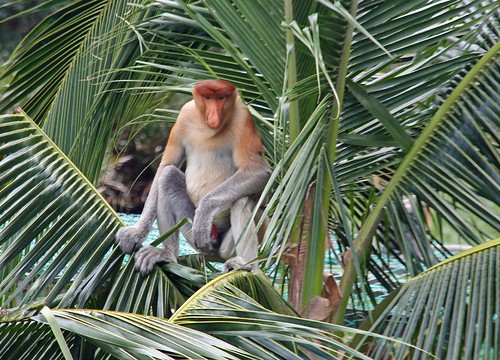
Dominant Male
What's more, the dominant male's purpose in life, other than defending his territory (and females) is producing as many offspring as possible. To this end, the dominant male sports a constant erection, a red tower of power out there in front for all to see. This state of constant arousal is even depicted in a painting at the sanctuary. Check out that photo above one more time. Click on it to go to Flickr, then click on "All Sizes." You'll see clear evidence of his dominant stature
The proboscis monkeys in Sabah acted much like other monkeys -- fighting for scraps, leaping from trees, tumbling in the foliage and squawking and screeching at regular intervals. The addition of that fantastic nose meant I couldn't take my eyes off of them.
I also saw silver-leaf langurs, mudskippers and a few hornbills. None of them could compete with the proboscis monkeys.
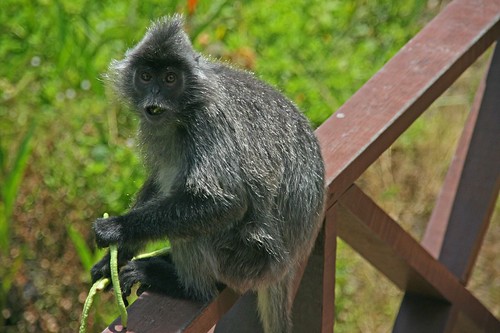
Silver-Leaf Langur
On the way back to Sandakan, Sonny and I stopped at Sandakan Memorial Park. I realized when I read about the park that one of the unexpected themes to emerge in my travels is the Japanese presence in the south Pacific during World War II. It started when I was in Darwin, Australia, where I read about the sinking of an American warship by Japanese bombers. During a visit to a Buddhist temple in Singapore, I heard about the occupation of the city by Japanese forces. Somewhere in the back of my brain I knew Borneo played a part in the war. I just never knew how awful it was.
The Japanese occupied Borneo in 1941, and soon thereafter created a few camps for prisoners of war. In Sandakan, Australian and British prisoners were forced to build an airstrip. The conditions were acceptable at the beginning, as acceptable as an prison camp could be, I assume. But as the war progressed, conditions worsened and the treatment of the prisoners turned brutal. With the Allies on the offensive in 1945, the Japanese marched their prisoners 250 kilometers through the jungle. Of the 2,400 prisoners interred at the Sandakan camp, only six survived, and only those because they escaped.
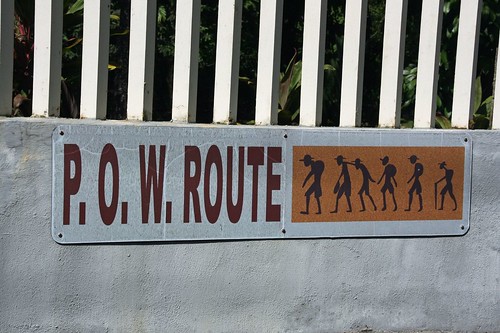
Entrance to Sandakan Memorial Park
Sandakan Memorial Park is situated in a quiet grove off the main road. There is a small exhibition hall with a model of the camp and a series of panels explaining the history of the camp as well as others with heartbreaking quotes from survivors. It is a wrenching tale of cruelty and survival.
I took a short walk through the shady grounds after visiting the center, wondering how those terrible acts could have happened on this peaceful plot of land.
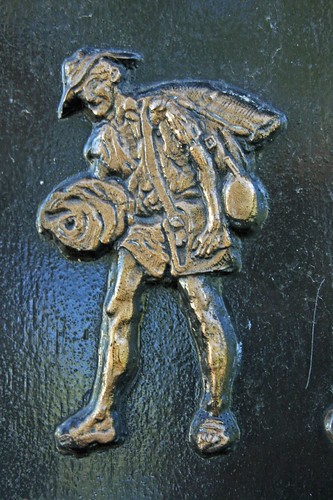
Plaque Detail Depicting POW on a Death March
The route from Sandakan to Ranau has been turned into a hiking trail. Tackling this trek may bring me back to Borneo someday.
I visit the orangutans tomorrow morning. I will then spend the next two nights in a jungle camp -- huts and mosquito nets, watch out for the crocodiles in the water -- next to the Kinabatangan River. I hope to see pygmy elephants and smell a rafflesia flower while I'm there.
I return to Kota Kinabalu on Friday night and will do my best to post an update before heading up the mountain.
Borneo, the third-largest island in the world, is not a country in and of itself. Indonesia and Malaysia share most of the real estate. The Malaysian states of Sabah and Sarawak cover the northern third of the island; the Indonesian state of Kalimantan covers the south. The tiny sultanate of Brunei has carved out of a sliver of land on the north coast roughly between Sabah and Sarawak. The name Borneo was applied by the Dutch during a period of colonization and it has stuck in Western minds.
I came to Sabah to climb Mount Kinabalu, the third-tallest mountain in Southeast Asia (13,435 feet). The parks department regulates the number of climbers who can be on the mountain at any one time, requiring climbers to reserve space in advance. I'm a fly-by-the-seat-of-his-pants traveler these days and didn't make arrangements before arriving in the city of Kota Kinabalu. Still, I was able to secure a spot on the mountain next weekend. That left me with six days to fill.
Tourists come to Sabah to climb the mountain or to see wildlife, both on land and below the sea. Probably the most famous inhabitants of the animal kingdom are the orangutans at the Sepilok Orangutan Rehabilitation Centre, 25 kilometers outside the town of Sandakan, which for me was a winding seven-hour bus ride from KK (the return trip will be by airplane). The orangutans are a must-see for me, but they will occupy one morning. A little research turned up another interesting monkey species, the Proboscis.
The Proboscis monkey is a an endangered species. There are only about 7,000 of them in the world and only in Borneo. As the name suggests, the monkey is distinguished by its huge schnozz. Actually, only the males have big noses. The females have dainty, pointy noses. I'm unable to decide if the creatures have unique features worthy of admiration or if they are just plain ugly. Buddy Ebsen and Mr. Magoo come to mind.
The Proboscis Monkey Sanctuary outside of Sandakan is not an easy place to get to. A visit would require either an overnight stay at an overpriced lodge in the jungle or an expensive taxi ride from the city. I settled on something in between -- I hired a driver for the day. We would visit the proboscis monkeys and then a memorial to a tragic chapter in world history.

Sonny, a local with little space in his brain for anything other than women, was living at the same waterfront hostel I'd booked into. We set out in the morning for the 90-minute trip. After 19 miles of paved highway, we turned onto a dirt road for a rough 15-kilometer ride into the jungle.
We arrived at the sanctuary about 45 minutes before the morning feeding. I killed the time watching a documentary about the monkeys, learning about their characteristics and behavior. Proboscis monkeys live in small groups, either based on a dominant male with a harem of females and offspring, or a bachelor group of young males who would vie for the females' attention. The
What makes this fairly common group dynamic interesting -- and if you don't find this interesting, get your head checked -- is that the size of the dominant male's nose plays some part in the attractiveness of that male monkey. The girls like the big beaks. The bigger than better.

What's more, the dominant male's purpose in life, other than defending his territory (and females) is producing as many offspring as possible. To this end, the dominant male sports a constant erection, a red tower of power out there in front for all to see. This state of constant arousal is even depicted in a painting at the sanctuary. Check out that photo above one more time. Click on it to go to Flickr, then click on "All Sizes." You'll see clear evidence of his dominant stature
The proboscis monkeys in Sabah acted much like other monkeys -- fighting for scraps, leaping from trees, tumbling in the foliage and squawking and screeching at regular intervals. The addition of that fantastic nose meant I couldn't take my eyes off of them.
I also saw silver-leaf langurs, mudskippers and a few hornbills. None of them could compete with the proboscis monkeys.

On the way back to Sandakan, Sonny and I stopped at Sandakan Memorial Park. I realized when I read about the park that one of the unexpected themes to emerge in my travels is the Japanese presence in the south Pacific during World War II. It started when I was in Darwin, Australia, where I read about the sinking of an American warship by Japanese bombers. During a visit to a Buddhist temple in Singapore, I heard about the occupation of the city by Japanese forces. Somewhere in the back of my brain I knew Borneo played a part in the war. I just never knew how awful it was.
The Japanese occupied Borneo in 1941, and soon thereafter created a few camps for prisoners of war. In Sandakan, Australian and British prisoners were forced to build an airstrip. The conditions were acceptable at the beginning, as acceptable as an prison camp could be, I assume. But as the war progressed, conditions worsened and the treatment of the prisoners turned brutal. With the Allies on the offensive in 1945, the Japanese marched their prisoners 250 kilometers through the jungle. Of the 2,400 prisoners interred at the Sandakan camp, only six survived, and only those because they escaped.

Sandakan Memorial Park is situated in a quiet grove off the main road. There is a small exhibition hall with a model of the camp and a series of panels explaining the history of the camp as well as others with heartbreaking quotes from survivors. It is a wrenching tale of cruelty and survival.
I took a short walk through the shady grounds after visiting the center, wondering how those terrible acts could have happened on this peaceful plot of land.

The route from Sandakan to Ranau has been turned into a hiking trail. Tackling this trek may bring me back to Borneo someday.
I visit the orangutans tomorrow morning. I will then spend the next two nights in a jungle camp -- huts and mosquito nets, watch out for the crocodiles in the water -- next to the Kinabatangan River. I hope to see pygmy elephants and smell a rafflesia flower while I'm there.
I return to Kota Kinabalu on Friday night and will do my best to post an update before heading up the mountain.

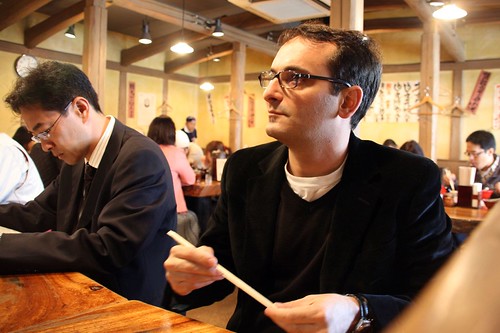

0 Comments:
Post a Comment
<< Home